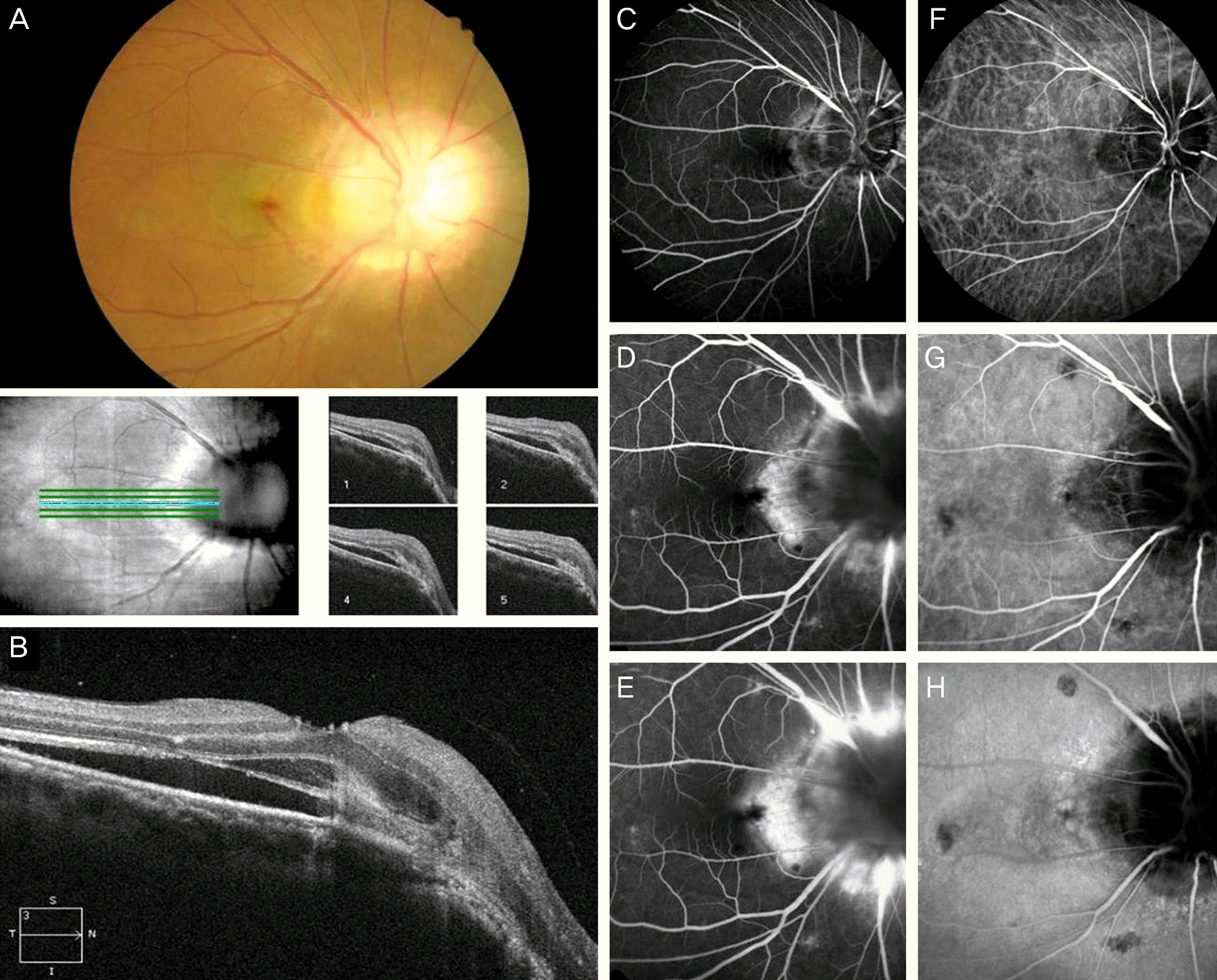Abstract
Purpose
We report a case of intravitreal bevacizumab injection for the treatment of choroidal neovascularization in morning glory syndrome.
Case summary
A 51-year-old male visited our hospital for a 1.5-year visual disturbance in his right eye. The patient's best-corrected visual acuity was 0.1 in the right eye. After fundus examination, we found characteristic findings of morning glory syndrome with submacular hemorrhage and serous retinal detachment in the right eye. Optical coherence tomography, fluorescein angiography and indocyanine green angiography were performed for evaluation. Retinoschisis, subretinal fluid, and choroidal neovascularization were detected, and thus bevacizumab was injected in the right eye. After intravitreal bevacizumab injection, retinoschisis was improved, and subretinal fluid was decreased. However, retinal pigment epithelial detachment was newly detected, and serous retinal detachment persisted. After 2 months, a second bevacizumab injection was performed. After these in-travitreal bevacizumab injections at 1 and 2 months, visual acuity was 0.4 and 0.6, respectively. Visual acuity improved to 1.0 after 3 months. Visual acuity was maintained for at least 6 months with no relapse of choroidal neovascularization.
References
1. Ryan SJ. Retina. 5th ed.Philadelphia: Elsevier/Mosby;2013. p. 1636–7.
2. Lit ES, D'Amico DJ. Retinal manifestations of morning glory disc syndrome. Int Ophthalmol Clin. 2001; 41:131–8.

3. Chang S, Gregory-Roberts E, Chen R. Retinal detachment associated with optic disc colobomas and morning glory syndrome. Eye (Lond). 2012; 26:494–500.

4. Chang S, Haik BG, Ellsworth RM, et al. Treatment of total retinal detachment in morning glory syndrome. Am J Ophthalmol. 1984; 97:596–600.

5. Choudhry N, Ramasubramanian A, Shields CL, et al. Spontaneous resolution of retinal detachment in morning glory disk anomaly. J AAPOS. 2009; 13:499–500.
6. Campos CC, Manzanaro PG, Rodilla JY, Martin Rodrigo JC. Retinal detachment associated with morning glory syndrome. Arch Soc Esp Oftalmol. 2011; 86:295–9.
7. Akamine T, Doi M, Takahashi H, et al. Morning glory syndrome with peripheral exudative retinal detachment. Retina. 1997; 17:73–4.
8. Sobol WM, Bratton AR, Rivers MB, Weingeist TA. Morning glory disk syndrome associated with subretinal neovascular membrane formation. Am J Ophthalmol. 1990; 110:93–4.

9. Chuman H, Nao-i N, Sawada A. A case of morning glory syndrome associated with contractile movement of the optic disc and subretinal neovascularization. Nippon Ganka Gakkai Zasshi Sep. 1996; 100:705–9.
Figure 1.
Baseline fundus photograph of the right eye (A) shows a large optic disc with funnel-shaped excavation, serous retinal detachment of the macula, and sumacular hemorrhage. Optical coherence tomography (B) shows serous retinal detachment, disruption of retinal pigment epitheilum layer and inner segment-outter segment line. Early, mid and late phases of fluorescin angiography (C-E) and indocynine green angiography (F-H) suggests occult choroidal neovascularization accompanied by morning glory syndrome.

Figure 2.
Two months after the 1st intravitreal bevacizumab injection, fundus photograph (A) and optical coherence tomography (B) of the right eye demonstrate absense of retinoschisis and decreased subretinal fluid, but serous retinal detachment persists as well as occurrence of a pigment epithelial detachment. Three months after the 2nd intravitreal bevacizumab injection, fundus photograph (C) and optical coherence tomography (D) of the right eye demonstrates disappearance of the subretinal fluid and persistent pigment epithelial detachment.





 PDF
PDF ePub
ePub Citation
Citation Print
Print


 XML Download
XML Download